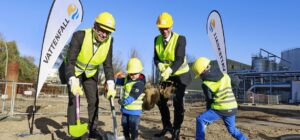 Vattenfall invests almost EUR 100 million in cutting-edge technology.
Vattenfall invests almost EUR 100 million in cutting-edge technology.
The next major step towards climate neutrality has been taken: Vattenfall is replacing the hard-coal-fired block of the Reuter CHP plant in Berlin’s district of Spandau with Europe’s largest power-to-heat plant, which has a capacity of 120 MWth. It will generate district heating from electrical energy. The construction works have begun at midday today, when Stefan Tidow, State Secretary for the Environment and Climate Protection, and Gunther Müller, Chairman of Vattenfall Wärme Berlin, performed the symbolic turn of the first sod.
The new plant works on the principle of immersion heating. It has a capacity equivalent to around 60,000 standard electric kettles. From 2020, it will generate district heating from electricity for up to 30,000 households, making it an essential part of Berlin’s heat revolution. Vattenfall Wärme Berlin will invest almost EUR 100 million in this project over the next two years. Once all of the heat-only boilers in this project have been commissioned, block C of the Reuter hard-coalfired CHP plant can be taken off the grid as planned following the 2019/2020 cold season.
Gunther Müller, Chairman of Vattenfall Wärme Berlin, explains: “Vattenfall is breaking new technological ground in Europe with the construction of this power-to-heat plant. Berlin is gaining a key advantage for the integration of renewable energies. If there is a surplus of renewable energy in the grid, the plant will use it to generate district heating at a low environmental impact. The renewable energy we generate for this will be equal to 10% of Berlin’s total energy demand in summer – or the output of 750,000 refrigerators. Thanks to the new power-to-heat plant, fewer wind turbines and PV installations will have to be throttled.”
Stefan Tidow, State Secretary for the Environment and Climate Protection, adds: “Berlin should be climate-neutral by 2050. Projects like the construction and commissioning of a power-to-heat plant are essential to achieving this goal. The future of energy is renewable. This is true not only for electricity generation, but for heating and ultimately also for the transport sector. In order to ensure that solar and wind energy can be used intelligently and efficiently, we have to focus on systematically integrating these areas. Today’s groundbreaking ceremony for this large-scale project is an important step towards a climate-neutral Berlin.”
With this project, Vattenfall is systematically pursuing its strategy to fully phase out coal in the German capital by 2030, while also meeting another criterion of the climate protection agreement with the State of Berlin. Lignite was already phased out at Klingenberg in May of this year – three years earlier than originally planned.
The project is also investing in hydraulic and electrical infrastructure and gas-fired heat-only boilers, which will cover consumption peaks in the district heating system and contribute to the security of supply. By 2030, Vattenfall expects to be able to expand “power-to-heat” solutions for the supply of district heating to 300 megawatts.
This investment is one of the projects under the umbrella of WindNODE, the north-east German model region for intelligent energy. Within the framework of the Smart Energy Showcase (SINTEG) programme, the Federal Ministry for Economic Affairs and Energy is sponsoring a total of five model regions in Germany – where solutions are being developed for an intelligent energy supply of the future – with increasing proportions of renewable energies.
Source: Vattenfall